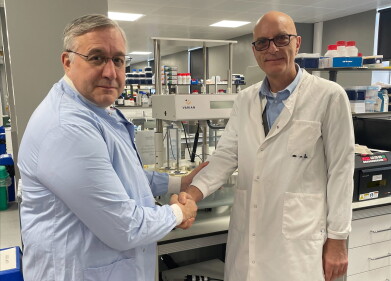News
Electron Beams Tuned to Chemical Reactions
Mar 27 2017
Electron Beams Tuned to Chemical Reactions
A multi-national team of scientists from the UK, Germany and Russia have succeeded in capturing inter-molecular reactions using the electron beam of a transmission electron microscope (TEM) as a stop-frame imaging tool. They have also discovered that the electron beam can be simultaneously tuned to stimulate specific chemical reactions by using it as a source of energy as well as an imaging too. This research – which shows chemical reactions happening in real time at one hundred-millionth of a centimeter - has the potential to revolutionise the study and development of new materials. It could help answer some of the most fundamental and challenging questions of chemical science; such as how molecules react with each other at the atomistic level; what drives formation of one product instead of another; as well as aid the discovery of brand new chemical reactions.
The team was led by Andrei Khlobystov a Professor of Nanomaterials at the University of Nottingham’s Nanoscale and Microscale Research Centre. “This is a significant scientific breakthrough. We have transformed the way we use TEM – from taking still images to a tool for filming and stimulating chemical reactions. It is the first time we have been able to watch chemical reactions at this level and observe the fate of molecules as the chemical reactions take place - from the starting molecules all the way through to the product.”
The research, carried out by experts in synthetic and theoretical chemistry, materials and electron microscopy and builds on Professor Khlobystov’s concept of carbon nano test tubes, (World’s tiniest test tubes, Guiness Book or World Records 2005) where the nanotubes act as a container for molecules. His pioneering work on carbon nanocontainers and nano-reactors is already leading to new ways of directing molecular assembley and studying chemical reactions.
Elena Besley, a professor of Theoretical Computation Chemistry and her team of researchers working in the Computational Naoscience Laboratory at Nottigham collaborated on the project. “Delving into the tiniest chemical building blocks of matter, our study harnesses the ‘observer effect’ and establishes an entirely new methodology for studying chemical reactions. We demonstrate that the electron beam, simultaneously acting as an imaging probe and a source of energy to drive chemical transformations, offers a new tool for studying the chemical reactions of individual molecules with atomic resolution, which is vital for the discovery of new reaction mechanisms and more efficient future synthesis,” she said.
Professor Khlobystov said: “We named our method ChemTEM because it is the most direct way of studying chemical reactions: the electron beam delivers well-defined amounts of energy directly to the atoms within the molecule and thus triggers a chemical reaction, whilst continuously imaging the molecular transformations, frame-by-frame in direct space and real time. We can discover new chemical reactions and make bespoke chemical structures by playing with the conditions of the TEM – for instance the energy of the electron beam.
The research was published in ACS Nano
Digital Edition
Lab Asia 32.2 April
April 2025
Chromatography Articles - Effects of small deviations in flow rate on GPC/SEC results Mass Spectrometry & Spectroscopy Articles - Waiting for the present to catch up to the future: A bette...
View all digital editions
Events
Apr 09 2025 Tokyo, Japan
Apr 22 2025 Hammamet, Tunisia
Apr 22 2025 Kintex, South Korea
Analytica Anacon India & IndiaLabExpo
Apr 23 2025 Mumbai, India
Apr 23 2025 Moscow, Russia



















